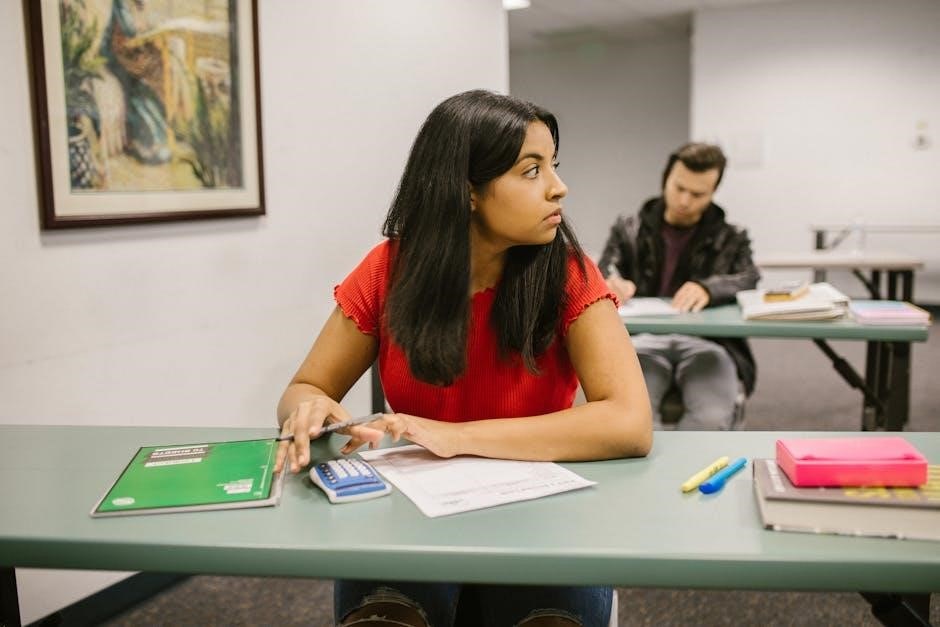The Year 3 Reasoning Test is a standardized assessment designed to evaluate cognitive skills and mathematical reasoning in students. It covers problem-solving, sequences, and real-world applications, preparing students for higher-level thinking.
1.1 What is the Year 3 Reasoning Test?
The Year 3 Reasoning Test is a standardized assessment designed for students in Year 3, typically around 8-9 years old. It evaluates cognitive and mathematical reasoning skills, focusing on problem-solving, critical thinking, and logical reasoning. The test includes questions on number sequences, word problems, and non-verbal reasoning, such as identifying patterns in shapes and diagrams. It aims to measure a student’s ability to apply mathematical concepts to real-world scenarios and abstract problems.
1.2 Importance of the Test for Year 3 Students
The Year 3 Reasoning Test plays a crucial role in assessing students’ cognitive abilities and learning potential. It helps identify strengths and areas needing improvement, ensuring tailored support. The test prepares students for future academic challenges and fosters confidence in problem-solving. Additionally, it provides teachers and parents with insights to guide individualized learning strategies, making it a valuable tool for overall student development.

Key Features of the Year 3 Reasoning Test
The test assesses problem-solving, number sequences, word problems, and real-world applications. It includes multiple-choice and short-answer questions, designed to evaluate critical thinking and mathematical reasoning skills effectively.
2.1 Structure and Format of the Test
The Year 3 Reasoning Test typically includes multiple-choice and short-answer questions, covering topics like number sequences, word problems, and real-world applications. The test may contain 14–20 questions, with a time limit of 35 minutes. Calculators are not permitted, and students can use space around questions for workings. Printable answer sheets are provided, allowing for easy marking and feedback. This format assesses problem-solving and reasoning skills effectively.

2.2 Question Types and Skills Assessed
The test includes diverse question types, such as number sequences, word problems, and non-verbal reasoning tasks. Students are assessed on skills like problem-solving, pattern recognition, and mathematical application. Questions often involve interpreting charts, telling time, and handling money. Non-verbal tasks focus on shapes, diagrams, and codes, requiring students to identify sequences and differences; These questions evaluate critical thinking and logical reasoning abilities effectively.

Preparation Strategies for the Test
Effective preparation involves using practice tests and printable worksheets to familiarize students with the format. Online tools and interactive resources enhance problem-solving and critical thinking skills.
3.1 Using Practice Tests Effectively
Using practice tests effectively is crucial for Year 3 students. Simulate test conditions to build familiarity and confidence. Time each session to improve speed and accuracy. Review answers to understand mistakes and identify areas needing improvement. Regular practice helps students recognize patterns and question types, ensuring they are well-prepared. Utilize printable resources for additional support and consistent practice.
3.2 Developing Problem-Solving Skills
Developing problem-solving skills is essential for success in the Year 3 Reasoning Test. Encourage students to break down problems into manageable steps. Practice exercises involving number sequences, patterns, and word problems enhance critical thinking. Regular exposure to real-world applications helps students apply mathematical concepts effectively. Foster a growth mindset to build confidence and resilience in tackling challenging questions.

Common Question Types in the Test
The Year 3 Reasoning Test includes diverse question types, such as number sequences, word problems, and real-world applications, designed to assess mathematical reasoning and critical thinking skills.
4.1 Number Sequences and Patterns
Number sequences and patterns are fundamental question types in the Year 3 Reasoning Test. These questions require students to identify the next number in a sequence or determine the missing shape in a pattern. They assess problem-solving skills, logical thinking, and the ability to recognize relationships between numbers or visual elements. Examples include predicting the next number in a mathematical sequence or completing a shape pattern. These questions help evaluate a student’s understanding of underlying mathematical concepts and their ability to apply reasoning skills to solve problems. They are designed to challenge critical thinking and ensure students can work independently and accurately.
4.2 Word Problems and Real-World Applications
Word problems and real-world applications are essential components of the Year 3 Reasoning Test. These questions involve practical scenarios, such as measuring, counting money, reading charts, and telling time. They require students to apply mathematical skills like addition, subtraction, multiplication, and fractions to solve everyday problems. This section assesses the ability to translate abstract concepts into real-life situations, making math relevant and engaging for young learners.

Time Management and Test-Taking Tips
Effective time management is crucial for the Year 3 Reasoning Test. Encourage students to read instructions carefully, allocate time per question, and skip difficult ones to return later.
5.1 How to Approach Different Sections
Students should approach each section methodically. For numerical reasoning, focus on identifying patterns and sequences. In word problems, highlight key information and visualize the scenario. For non-verbal tasks, analyze shapes and diagrams systematically. Encourage skimming instructions first, managing time per question, and reviewing answers if possible. Practicing under timed conditions helps build confidence and efficiency.
5.2 Strategies for Completing the Test Within the Time Limit
To complete the test efficiently, practice under timed conditions to simulate the real exam. Skim instructions quickly and focus on high-value questions first. Allocate specific minutes per question and avoid spending too long on one problem. Use a systematic approach to eliminate incorrect answers and make educated guesses if necessary. A quick review of unanswered questions at the end can help maximize scores.

Resources Available for Test Preparation
Students and educators can access printable worksheets, PDF guides, and online tools. These resources include practice tests, interactive activities, and detailed answer sheets to support effective preparation.
6.1 Printable Worksheets and PDF Guides
Printable worksheets and PDF guides are essential tools for Year 3 students preparing for the reasoning test. These resources often include practice questions, answer keys, and detailed explanations, allowing students to familiarize themselves with test formats and improve their problem-solving skills. Many guides are specifically designed to cover curriculum aims, ensuring comprehensive preparation for various question types and cognitive challenges.
6.2 Online Tools and Interactive Resources
Online tools and interactive resources offer dynamic ways to prepare for the Year 3 reasoning test. Many platforms provide interactive tests, timed assessments, and adaptive difficulty levels to simulate real test conditions. These resources often include instant feedback, progress tracking, and detailed explanations, helping students identify strengths and areas for improvement. Interactive games and puzzles also make learning engaging while developing critical thinking and problem-solving skills.

Analyzing Test Results and Improving Performance
Analyzing test results helps identify strengths and areas needing improvement. Reviewing answers and understanding mistakes guides targeted practice, fostering better problem-solving skills and confidence over time.

7;1 Understanding the Scoring System
The scoring system for the Year 3 Reasoning Test is designed to measure cognitive abilities and mathematical skills accurately. Each question is awarded marks based on difficulty, with total scores indicating overall performance. Detailed breakdowns help identify strengths and weaknesses, allowing for focused improvement strategies. Understanding the scoring system enables students and educators to set realistic goals and track progress effectively.
7.2 Identifying Areas for Improvement
Analyzing test results helps pinpoint areas where students need extra support. Reviewing incorrect answers and understanding common mistakes is crucial. Printable worksheets and practice tests can target specific skills, such as number sequences or word problems. By breaking down performance into key categories, educators and parents can create focused study plans to address weaknesses and build confidence. Regular practice and feedback are essential for steady improvement.

Tips for Parents and Teachers to Support Students
Parents and teachers can support students by providing practice tests, creating a structured study schedule, and fostering a positive learning environment. Encourage critical thinking and regular feedback to help students improve their reasoning skills.
8.1 Creating a Study Schedule and Environment
Establishing a consistent study schedule helps students stay focused and prepared. Allocate specific times for practice tests and problem-solving activities, ensuring a balance between learning and breaks. Create a quiet, organized workspace free from distractions to promote effective learning. Encourage the use of printable worksheets and online tools to reinforce reasoning skills.
Consistency and positive reinforcement are key. Regularly review progress and provide constructive feedback. A well-structured study environment fosters confidence and readiness for the test.
8.2 Encouraging Critical Thinking and Reasoning
Encourage students to engage in activities that promote critical thinking, such as solving puzzles or analyzing real-world problems. Use interactive tools and group discussions to foster reasoning skills. Provide opportunities for students to explain their thought processes, helping them articulate their ideas clearly.
Break down complex problems into smaller steps and relate them to familiar scenarios. This approach builds confidence and enhances their ability to think logically and creatively. Regular practice with reasoning exercises will strengthen their problem-solving abilities over time.
Mastering the Year 3 Reasoning Test requires consistent practice and a focus on problem-solving skills. Utilize available resources like worksheets and online tools to ensure readiness and confidence.
9.1 Summarizing Key Points
The Year 3 Reasoning Test assesses problem-solving and critical thinking skills, focusing on number sequences, word problems, and real-world applications. Regular practice with worksheets and online tools enhances readiness. Encourage a structured study schedule and a positive mindset to build confidence. Understanding test results helps identify areas for improvement, ensuring students are well-prepared for future challenges.
9.2 Encouraging Confidence and Readiness
Building confidence is key to excelling in the Year 3 Reasoning Test. Encourage students to practice regularly and praise their efforts, fostering a growth mindset. Provide a calm, supportive environment for studying and test-taking. Remind them that understanding their strengths and areas for improvement helps them approach challenges with positivity. Confidence grows when students feel prepared and valued, ensuring they perform to the best of their abilities.




Leave a Reply
You must be logged in to post a comment.